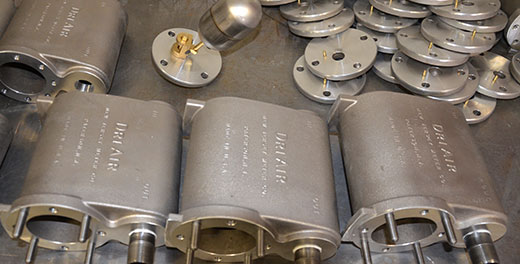Fascination About Aluminum Castings Company
Table of ContentsThe 25-Second Trick For Aluminum Castings CompanyThe Greatest Guide To Aluminum Castings CompanyHow Aluminum Castings Company can Save You Time, Stress, and Money.The 45-Second Trick For Aluminum Castings CompanyAluminum Castings Company Things To Know Before You Get ThisGetting The Aluminum Castings Company To WorkAluminum Castings Company Can Be Fun For Anyone10 Easy Facts About Aluminum Castings Company Shown
There are two key kinds of die casting utilized in the light weight aluminum spreading sector: warm chamber die spreading and cold chamber die casting. The primary distinction between these approaches is exactly how the molten metal is provided to the mold. In warm chamber die casting, generally used for lower melting point metals, the melting pot is directly linked to the machine, and a bettor forces the material through a gooseneck into the die cavity.
Indicators on Aluminum Castings Company You Should Know
In these approaches, the mold and mildew is purposefully damaged or broken away in order to extract the ended up aluminum casting. Usual processes under the classification of expendable mold casting include (financial investment casting),,, and financial investment casting. When making personalized aluminum parts utilizing expendable mold and mildews, makers pour liquified light weight aluminum or light weight aluminum alloys right into the mold and mildew, which is then damaged apart to release the solidified steel component.
The is among the earliest and most favored types of light weight aluminum spreading. It entails condensing specialty shop sand, usually reinforced with clay or resin, around a precisely crafted multiple-use pattern that establishes the shape and inner information of the ended up aluminum product. The pattern system incorporates risers and vents to manage the circulation of molten metal and to avoid casting defects such as shrinkage porosity.
Unknown Facts About Aluminum Castings Company

This mold and mildew is after that preheated prior to the putting of molten aluminum or light weight aluminum alloy. As the steel fills up the shell, it captures the elaborate details and fine surface area coating of the mold. As soon as cooled, the ceramic is mechanically or chemically escaped, enabling the removal and separation of private actors parts.
Some Known Factual Statements About Aluminum Castings Company
Irreversible mold and mildew spreading uses multiple-use metal mold and mildews and is optimal for mass production with constant top quality and less waste. Expendable mold and mildew spreading uses single-use molds, like sand or foam, using layout flexibility and reduced tooling prices for models or short runs. Pass away spreading is best for producing high volumes of aluminum parts that need tight resistances, great information, and smooth surface areas.
The Toshiba Equipment DC-J Collection consists of die casting makers appropriate for aluminum. Known for their robust building and construction and high shot efficiency, these machines ensure efficient and precise casting (Sand Molding).

While light weight aluminum can be utilized in its pure type, it is commonly alloyed with other steels to enhance its buildings or the properties of the other metals. These alloys offer enhanced performance for different applications. Aluminum alloys are categorized right into 8 series, numbered from one to eight. The first figure(s) of the number suggest the primary alloying element combined with light weight aluminum.
The 5-Minute Rule for Aluminum Castings Company
This alloying enhances the strength and hardness of light weight aluminum yet decreases its ductility and rust resistance. The 2000 series alloys are testing to weld however can be warmth dealt with to enhance their residential properties. The 3000 collection alloys are primarily alloyed with manganese. This combination boosts deterioration resistance while giving modest strength.
Additionally, it features high ductility and a really smooth finished surface. The 4000 series alloys are alloyed with silicon, which reduces the melting point and boosts fluidness. This makes it a preferred selection for casting, as it is easy to form in its molten state. The 4000 collection is additionally typically utilized as a filler for welding and brazing applications.
Aluminum Castings Company Can Be Fun For Anyone
This series is classified as a high-strength alloy, specifically fit for sheet and plate applications because of its exceptional weldability. Its resistance to corrosion from acids and alkalis makes it ideal for use in rough and aggressive settings (Aluminum Castings). The 6000 collection alloys are alloyed with both magnesium and silicon, supplying a balance of strength, mechanical homes, and corrosion resistance
Handling the 6000 collection needs specialized and sophisticated devices, which can be complex and costly. Nonetheless, this series is recognized for its outstanding corrosion and oxidation resistance, along with its convenience of covering, treatment, and workability. The 7000 series light weight aluminum alloys are the best and most resilient among light weight aluminum kinds, with toughness comparable to about two-thirds of industrial-grade A3 steel.
The Greatest Guide To Aluminum Castings Company
Zinc is the main alloying element in the 7000 collection, enhancing the hardness of the aluminum, also though zinc's solidity is similar to that of aluminum on the Mohs scale. The 8000 series light weight aluminum alloys are primarily alloyed with tin, along with tiny amounts of copper and nickel (Sand Foundry). While these alloys use lower toughness compared to various other series, they succeed in machinability and wear resistance
Aluminum cast heatsinks are electrically conductive, permitting them to be based effectively. They are often cast with incorporated attributes that minimize the requirement for secondary operations, such as extra machining or setting up, resulting in more cost savings. Light weight aluminum casting is frequently used to produce braces for both durable commercial equipment and YOURURL.com home devices.
Aluminum Castings Company Fundamentals Explained
The single-piece building of aluminum brackets boosts their toughness and resilience, decreasing the likelihood of failure. If holes are called for, they can be included straight in the spreading mold, reducing the need for post-production completing (https://go.bubbl.us/ee7a02/dd42?/New-Mind-Map). Makers have increasingly adopted aluminum spreading for golf devices as a result of its sturdiness, security, and adaptability in shaping